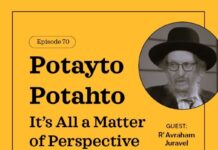 Pesach is primarily known as the Jewish holiday celebration of freedom, which also happens to feature a myriad of rules concerning food. There are foods we must eat such as matzah and there are foods one is forbidden to consume such as chometz. Chometz is defined by halacha (Jewish law) as the product of one of the five forbidden grains which has come into contact with water and become fermented. These biblically prohibited grains are wheat, oats, barley, rye and spelt. These grains may not be consumed in any form out of concern that they may have come into contact with water and become chometz. The one exception to this is, of course, if these grains are milled into Pesach flour and baked into matzah with full time rabbinical supervision.
Pesach is primarily known as the Jewish holiday celebration of freedom, which also happens to feature a myriad of rules concerning food. There are foods we must eat such as matzah and there are foods one is forbidden to consume such as chometz. Chometz is defined by halacha (Jewish law) as the product of one of the five forbidden grains which has come into contact with water and become fermented. These biblically prohibited grains are wheat, oats, barley, rye and spelt. These grains may not be consumed in any form out of concern that they may have come into contact with water and become chometz. The one exception to this is, of course, if these grains are milled into Pesach flour and baked into matzah with full time rabbinical supervision.
The halacha only forbids these five grains. However, beginning in medieval times, Ashkenazic communities added kitniyos to the list of prohibited species. Kitniyos includes other grain-like items such as rice and corn as well as seeds and beans.
Various reasons are given for this prohibition. In some cases flour can be made out of these species. In other cases, the seeds of the species resemble forbidden grain kernels. Both of these circumstances could cause some to confuse kitniyos with actual grains. Additionally, in yet other situations, kitniyos and grain crops are grown in close proximity to one another and grain may become mixed into kitniyos varieties. While the reasons are in some cases unclear or seemingly irrelevant, it remains definite that Ashkenazic practice prohibits consumption of the full range of kitniyos species. Non-Ashkenazic communities never accepted this prohibition and in general continue to use kitniyos on Pesach. However, some of these communities do forbid the usage of certain kinds of kitniyos on the holiday. This depends on local communal custom.
It is also somewhat unclear what is included in the category of kitniyos. Since the prohibition is based on binding custom there is no general principle which can be followed here. Basically, whatever has been accepted over the generations as kitniyos is prohibited and everything else remains permitted. There is no doubt that rice, millet, corn and buckwheat have always been considered kitniyos. The same is true of the many species of beans and peas. Seeds and spices are more open to question and to varying local customs in different parts of the Ashkenazic world.
Sesame seeds, mustard, sunflower seeds, cardamom (an herbal seed which grows in a pod), fennel and poppy seeds are universally considered to be kitniyos. There are different opinions about coriander, cumin and anise. The OU poskim (halachic decision makers) consider these not to be kitniyos. However, the spices require special care for Pesach use since kitniyos and even chometz grains are frequently mixed into them. Peanuts were considered kitniyos in some parts of Europe and permitted in others. Present day practice is to consider them kitniyos. The OU does not permit quinoa and amaranth in products certified for Pesach use, but suggests that individuals ask their own rabbi for guidance on home use.
There is a further disagreement regarding kitniyos oil and other kitniyos derivatives. Some authorities forbid them while others maintain that only kitniyos in the original form are prohibited. Present day practice is to prohibit these items on Pesach. The OU and many other kosher agencies accept kitniyos derivatives when the product has undergone a complete chemical change and bears no resemblance to the original kitniyos. This includes items such as citric acid and aspartame which are derived at least in part from corn which has gone through many chemical changes to reach its current state.
{OU.org/Noam Amdurski-Matzav.com Newscenter}











